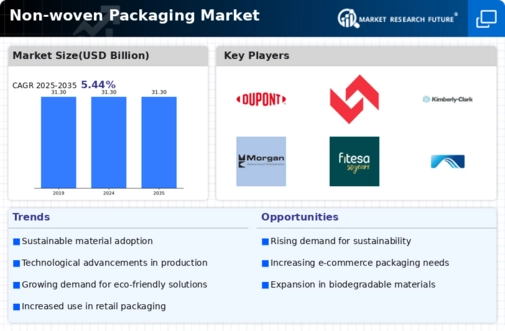Regulatory Support
Regulatory support significantly influences the Global Non-woven Packaging Market Industry, as governments worldwide implement policies promoting the use of sustainable packaging solutions. Initiatives aimed at reducing plastic waste and encouraging biodegradable materials are prompting manufacturers to explore non-woven options. For example, several countries have introduced regulations that favor the use of non-woven packaging over traditional plastic alternatives. This regulatory landscape is likely to foster innovation and investment in the non-woven sector, contributing to the industry's projected stability, with a CAGR of 0.0% from 2025 to 2035, indicating a steady demand for non-woven products.
Consumer Preferences
Shifting consumer preferences are a driving force in the Global Non-woven Packaging Market Industry, as buyers increasingly seek convenience and functionality in packaging solutions. Non-woven materials are lightweight, durable, and versatile, making them ideal for various applications, from retail to food packaging. The growing trend of online shopping further amplifies the demand for non-woven packaging, as businesses strive to provide secure and attractive packaging for shipped products. This evolving consumer landscape is expected to sustain the market's growth trajectory, with the industry projected to maintain a value of 31.3 USD Billion by 2035, reflecting the enduring appeal of non-woven solutions.
Sustainability Trends
The Global Non-woven Packaging Market Industry is increasingly influenced by sustainability trends as consumers and businesses prioritize eco-friendly solutions. Non-woven materials, often made from recycled fibers, offer a more sustainable alternative to traditional packaging. This shift is evident as companies adopt non-woven packaging to reduce their carbon footprint and enhance brand image. For instance, major retailers are integrating non-woven bags into their supply chains, reflecting a growing preference for sustainable packaging options. This trend is expected to drive the market, with the industry projected to reach 31.3 USD Billion by 2024, highlighting the importance of sustainability in shaping consumer choices.
Market Diversification
Market diversification within the Global Non-woven Packaging Market Industry is evident as manufacturers explore new applications and sectors. Non-woven materials are increasingly utilized in healthcare, agriculture, and personal care, expanding their market reach beyond traditional packaging. This diversification allows companies to tap into emerging markets and cater to a broader range of consumer needs. As industries recognize the benefits of non-woven packaging, such as cost-effectiveness and customization options, the market is poised for growth. The industry's stability, with a projected CAGR of 0.0% from 2025 to 2035, suggests that diversification strategies will play a crucial role in maintaining market relevance.
Technological Advancements
Technological advancements play a pivotal role in the Global Non-woven Packaging Market Industry, enhancing production efficiency and product quality. Innovations in manufacturing processes, such as spunbond and meltblown technologies, enable the creation of high-performance non-woven materials that meet diverse packaging needs. These advancements not only improve the durability and functionality of non-woven packaging but also reduce production costs. As a result, manufacturers are increasingly investing in state-of-the-art equipment to stay competitive. The anticipated market value of 31.3 USD Billion by 2024 underscores the impact of technology on driving growth within the industry.






















Leave a Comment